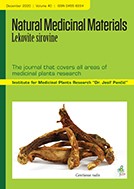Institute of Field and Vegetable Crops - National Institute of the Republic of Serbia , Novi Sad , Serbia
Institute of Field and Vegetable Crops - National Institute of the Republic of Serbia , Novi Sad , Serbia
Institute of Field and Vegetable Crops - National Institute of the Republic of Serbia , Novi Sad , Serbia
Nepeta nuda L. (syn. N. pannonica L.) is a herbaceous perennial plant, is the most widespread species of the genus Nepeta, the largest genera in Lamiaceae family. However, N. nuda is well spread worldwide, and divided into four subspecies according to morphological differences which occur within large geographical range of distribution: subsp. nuda, subsp. albiflora, subsp. lydiae and subsp. glandulifera. In this review, previous reports on N. nuda concerningits botanical description and systematics, phytochemistry, use in traditional medicine, pharmacology, and posibilities for other applications were critically summarized. This paper includes data about N. nuda phytochemical compounds, ethnomedicinal uses, pharmacological properties, and prospect of it being applied as a natural herbicide an in management of plant diseases. All of this contributes to N. nuda being a highly promising plant in food and pharmaceutical industries, as well as in agriculture for the development of natural pesticides.
This is an open access article distributed under the Creative Commons Attribution License which permits unrestricted use, distribution, and reproduction in any medium, provided the original work is properly cited.

The statements, opinions and data contained in the journal are solely those of the individual authors and contributors and not of the publisher and the editor(s). We stay neutral with regard to jurisdictional claims in published maps and institutional affiliations.